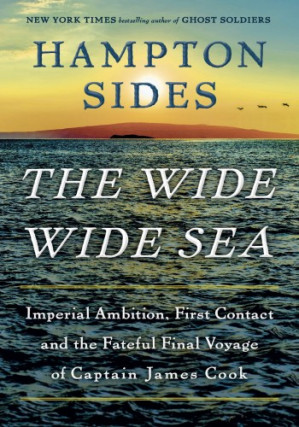Science traveled with sabers.
Cook gathered astronomical and botanical data even as the Admiralty sought new colonial footholds.

Book summary
by Hampton Sides
Imperial ambition, first contact, and the fateful final voyage of Captain James Cook
Cook’s final voyage retold through Indigenous and imperial eyes
Topics
Read this as a dual narrative—track Cook's imperial ambitions while noting Indigenous perspectives. Use Readever to highlight cultural misunderstandings and power dynamics, then compare how different sources interpret the same events. The AI insights will help you see patterns in cross-cultural communication that remain relevant today.
Things to know before reading
Hampton Sides reconstructs Cook’s third expedition (1776–79) as a collision of motives: Enlightenment science, imperial competition with Spain and Russia, and Pacific Islander sovereignty. Drawing on Hawaiian, Māori, and Nuu-chah-nulth oral histories alongside Royal Navy logs, he shows how misunderstandings about ritual, property, and reciprocity set the stage for Cook’s death at Kealakekua Bay.
Sides focuses on three tensions: science vs. sovereignty, charisma vs. hubris, and myth vs. memory.
Cook gathered astronomical and botanical data even as the Admiralty sought new colonial footholds.
Hawaiian aliʻi treated Cook’s arrivals as sacred ceremonies; the British saw logistical pit stops.
Pacific voices recast Cook not as a martyr but as a flawed visitor who ignored warnings.
Ready to continue? Launch the Readever reader and keep turning pages without paying a cent.
The book gives you granular scenes—surf landings, gift exchanges, smallpox scares—that make it easier to explain why “discovery” narratives still fuel debates about sovereignty, conservation, and cultural restitution today.
Key idea 1
Cook gathered astronomical and botanical data even as the Admiralty sought new colonial footholds.
Precision tools like the marine chronometer expanded empire by allowing accurate maps. Sides urges readers to see data collection and territorial claims as mutually reinforcing, not separate pursuits.
Remember
Key idea 2
Hawaiian aliʻi treated Cook’s arrivals as sacred ceremonies; the British saw logistical pit stops.
The narrative details gift obligations, kapu (taboos), and the fallout when Cook tried to detain a chief over a stolen longboat. It’s a crash course in why humility and cultural translators belong on every expedition.
Remember
Key idea 3
Pacific voices recast Cook not as a martyr but as a flawed visitor who ignored warnings.
Sides juxtaposes British memorials with Hawaiian chants and modern protests, showing how historical narratives evolve when Indigenous scholars hold the microphone.
Remember
History buffs drawn to maritime epics with contemporary relevance.
Leaders planning cross-cultural initiatives or expeditions.
Educators teaching Pacific history, empire, or navigation.
Hampton Sides is a New York Times bestselling historian and journalist whose previous works include In the Kingdom of Ice and Ghost Soldiers. He is known for immersive narratives that blend archival digging with on-location reporting.
Build your personalized reading stack
Download full-length ePubs in one click with personal cloud storage.
Blend AI-guided insights with tactile note-taking to accelerate reflection.
Follow curated reading journeys tailored to your goals and time budget.
Sync highlights across devices so lessons stick beyond the page.
Sign in to Readever to keep reading with AI guidance, instant summaries, and synced notes.
Start reading The Wide Wide Sea for free and unlock personalized book journeys with Readever.